This bok choy stir fry might be downright simple for some people, especially those who grew up in a typical Cantonese family. However, it is deceptively tricky to recreate this iconic Chinese dish at home to taste like those from the restaurant.
This bok choy stir fry recipe will address all the nitty-gritty.
Bok choy is as popular as gailan (Chinese broccoli) and choy sum and is extremely easy to cook. I have cooked this vegetable numerous times by following my mom’s methods and experimenting with different techniques. Eventually, I settled on the method deemed the best for my family.
Note: This post may contain affiliate links. Please read my privacy policy for more info. I may receive commissions for purchases made through links in this post. As an Amazon Associate, I earn from qualifying purchases.
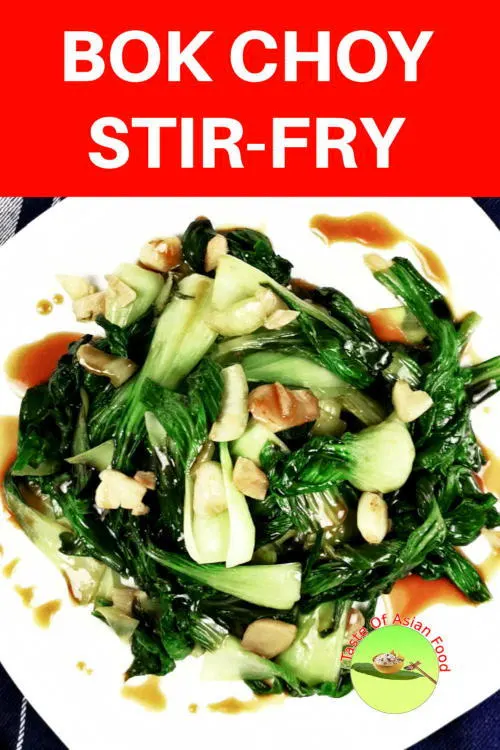
What is Bok Choy
Bok choy is also translated as bak choi, pak choi, bái cài, or bak choy, all of which are from the word 白菜. The differences are due to the slight phonetic difference between the Chinese dialects.
The direct translation of 白菜 is ‘white vegetables,’ but they might not necessarily be white. Bok choy leaves are crisp, with a slightly grassy taste, and mildly bitter. The stalks are either white (yes!), but some can be pale green. The texture is crispy, with a nice celery-like crunch.
The taste of bok choy is mild and relatively neutral. It is versatile and can be cooked in different ways with various seasonings.
There are many species, but for culinary purposes, I would group them into the large and baby bok choy, as the cooking methods are slightly different.
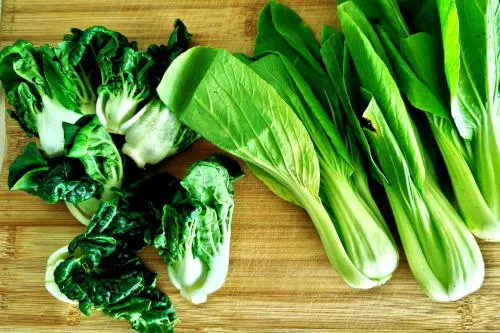
How to stir-fry bok choy
The most common disparity between the home-cooked and restaurant versions is that there is not enough wok aroma, and the stem is either too tough or soft.
Here is a step-by-step breakdown of my methods to recreate this iconic Chinese dish at home.
1. Prepare bok choy for stir-frying
Baby bok choy
Since baby bok choy is only about two to three inches long, it is better not to cut it or remove the leaves to preserve its appearance. After all, the stalks are pretty tender, which means that they will be tender-crisp when cooked with the leaves simultaneously.
Rinse the baby bok choy with tap water in a large container or pot. Change the water two to three times to remove all the dirt and sand. Place the bok choy in a colander to drain the excess water.
Large bok choy (the regular bok choy)
Since they are larger, cut off half to one cm of the stem from the root portion. Separate each stalk and wash separately, using running water or plunging a few times into a pot of water to remove the dirt.
Next, cut or snap each stalk crosswise to separate the leaves and the stems. Drain the leaves and stalks separately in different colanders.
Cut the stems on the bias to break the fiber. This will make the stem tender-crisp and not need to be cooked excessively long to become soft, as the color of bok choy will turn dull after prolonged cooking.
Another method is to cut the large bok choy down the center to create two halves. This method reveals the stunning pattern of the stem and still keeps the structure intact. However, the structure is fragile, so it is more appropriate for blanching or pan-frying.
2. Which is better- to blanch or not to blanch?
Some cooks prefer to blanch the stem of the large bok choy before stir-frying since it takes longer to cook through than the leaves. I used to blanch the larger stems separately with boiling water for a few minutes, then add them to the leaves to stir fry so they would become tender-crisp simultaneously. My method has slightly evolved, as I thought it was faster to skip blanching.
My current method is to stir-fry the stem over high heat for two minutes, add the leaves, and continue cooking. They will cook to tender-crisp simultaneously and save the step to blanch in a separate pot of water.
3 How to season the bok choy
There are four essential ingredients required in this stir fry bok choy recipe.
Garlic is the primary ingredient you must have. In Chinese cooking, it is almost universally used for all types of stir-fried vegetables.
Coarsely chop the garlic for stir-frying bok choy. There is no need to finely chop or mince the garlic, which has a counter effect. Since stir-frying involves high heat, minced garlic tends to burn quickly.
The second item is ginger. It is always great to add two to three thinly sliced ginger along with the garlic. This is the classic combination almost used together in all Chinese recipes. It is also a perfect combination in Indian cuisine, usually combined as ginger-garlic paste.
Some say that ginger can counterbalance the cooling effect of leafy greens, although that is not why I use it. I just love its taste!
Bok choy is slightly bitter, so I always add a small teaspoon of sugar to balance the bitterness.
Lastly, season with salt. This bok choy stir fry recipe highlights the vegetable’s taste, texture, and mouthfeel. You seldom hear about bok choy used in other heavily seasoned dishes, such as curries.
4. Use a stir-fry sauce (bok choy with oyster sauce recipe)
If you want to prepare a more savory version, I suggest using simple soy and oyster sauce to switch it to the bok choy with oyster sauce recipe. Remember that the sauce should not overpower but accent the bok choy flavors.
- Combine some light soy sauce, oyster sauce, sesame oil, and water in a small pan.
- Bring it to a boil to thicken it slightly.
- Drizzle the sauce on the bok choy before serving.
I do not suggest stirring the bok choy with this sauce, although I term it a stir-fry sauce. The sauce will take away the vibrant, fresh green color of the bok choy once you stir-fry together. I prefer to retain the color of the bok choy and use the sauce as dressing.
Note: If you want to make it vegan, you can use the vegetarian oyster sauce made with mushroom extract.
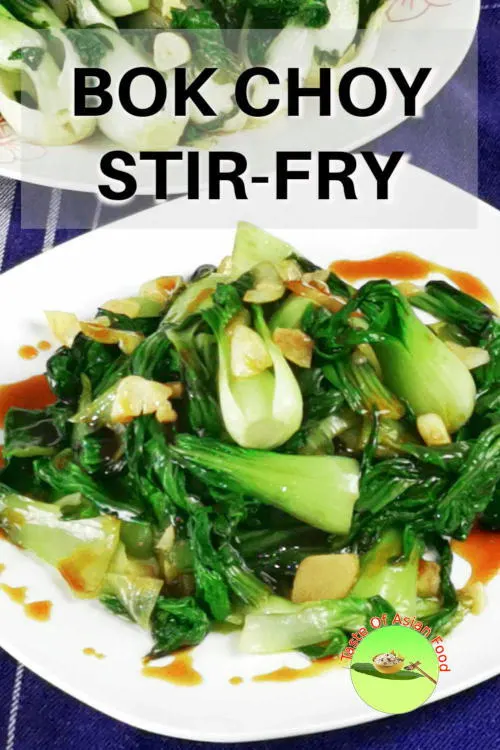
5. Stir fry the bok choy
Here are the steps for baby bok choy stir-fry
- Heat some oil in the wok.
- Add the coarsely chopped garlic and ginger and saute over low to medium heat until fragrant and slightly brown. High heat is not recommended, as it will burn the garlic quickly.
- Add the bok choy to the wok. You will hear a loud sizzling sound throughout the entire stir-fry time.
- Turn the heat to high. Continue to stir fry over high heat to generate the wok aroma.
- Season with salt and sugar at any time during the stir-frying process.
- Whenever the liquid in the wok starts to dry out, add one to two tablespoons of water to the wok to continue stir-frying over high heat. Try to keep a minimum of water in the wok, as too much water will reduce the wok’s aroma. There should be a constant sizzling sound throughout the stir-frying process.
- Depending on the size of the bok choy, check the doneness (the best is to eat one to test), and dish out immediately when it is tender-crisp. If it is not done yet, add another tablespoon of water to stir fry further. Keep an eye on the color of the bok choy, as it will lose its vibrant color if you overcook it.
Here are the steps to stir-fry the large bok choy
Stir fry the stems
- Heat some vegetable oil in the wok or a large skillet over low to medium heat for the small bok choy.
- Saute part of the coarsely chopped garlic and ginger slices until aromatic.
- Add the drained, sliced bok choy stems and stir fry over high heat. If the mixture is too dry, add a tablespoon of water at a time. Add a small amount of water over high heat until the stems are tender-crisp, about two minutes. Of course, the actual timing depends on the size and thickness of the bok choy stems.
- Remove the stems from the wok.
Combine the stems with the leaves
- Add some oil to the pan. Saute the remaining garlic and ginger until aromatic.
- Add the bok choy leaves and stir fry until they start to wither, which will take a minute or two. Add one or two tablespoons of water if the mixture is too dry.
- Return the nearly cooked stems to the wok. Season the bok choy with salt and sugar.
- Continue stir-frying over high heat until the water is nearly dried out. Transfer it to the serving plate.
Related dishes to bok choy stir fry recipe
If you like this bok choy stir-fry recipe, you are likely interested in trying the following recipes.
Try to make Bok choy soup with pork by following this recipe. Bok choy is more than just stir-fry!
Gailan (Chinese broccoli) stir fry. This is my earlier article describing how to stir-fry gailan. I blanch the vegetables briefly in this recipe. You can refer to it if you like to use the blanching method.
Chicken and broccoli stir-fry is a breeze to prepare. It is the ideal dish when you are short of time cooking or have a sudden craving for Chinese take-out.
This vegetable stir-fry is quick and easy. Stir-frying adds a whole new dimension to your plain vegetables. Give it a try if you like broccoli, cauliflower, snow peas, and bell peppers.
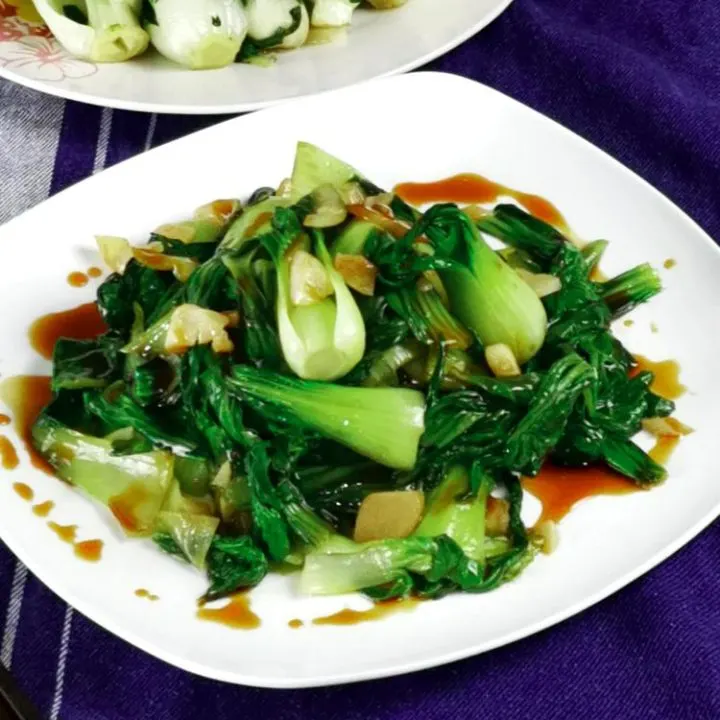
Bok choy stir fry - easy restaurant style recipe
Bok choy stir fry might be downright simple for some people, especially those who grew up in a typical Cantonese family. However, it is deceptively tricky to recreate this iconic Chinese dish at home to taste like those from the restaurant.
This bok choy stir fry recipe will address all the nitty-gritty.
Ingredients
Ingredients A
- 400g bok choy of your choice
- 5 cloves garlic, coarsely chopped
- 3 slices ginger
- 1/2 tsp salt
- 1 tsp sugar
- 1/4 tsp ground white pepper
Ingredients B (Sauce)
- 1 tbsp oyster sauce
- 1 tsp light soy sauce
- 1/2 tsp sesame oil
- 1 tbsp water
Instructions
- Rinse the baby bok choy with water to remove all the dirt and sand. Drain.
- Heat some oil in the wok. Saute the coarsely chopped garlic and ginger over low to medium heat until fragrant.
- Add the bok choy to stir-fry over high heat.
- Season with salt, sugar, and white pepper.
- Add some water if it is too dry, 1-2 tbsp at a time,
- Stir-fry until the bok choy is tender-crisp.
- Bring all the Ingredients in B to a boil in a small pan to thicken it. Set aside.
- Drizzle the sauce on the bok choy. Serve.
Variation for larger bok choy
- Separate the leaves from the stem.
- Cut the stem into short sections on a bias.
- Stir fry the stem and the leaves separately.
- When both are tender and still crisp, combine both in the wok, season with salt, sugar, and pepper.
- Transfer to the serving plate.
Recommended Products
As an Amazon Associate and member of other affiliate programs, I earn from qualifying purchases.
Nutrition Information:
Yield: 2 Serving Size: 1Amount Per Serving: Calories: 95Total Fat: 2gSaturated Fat: 0gTrans Fat: 0gUnsaturated Fat: 1gCholesterol: 0mgSodium: 1020mgCarbohydrates: 19gFiber: 2gSugar: 3gProtein: 2g
This data was provided and calculated by Nutritionix on 4/10/2021


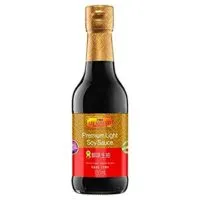


Boy Choy Stir Fry with Garlic
Wednesday 17th of December 2025
[…] Recipe by: tasteasianfood […]
Bok Choy Stir Fry Recipe Delicious Easy Asian Dinner Guide
Monday 8th of December 2025
[…] tutorials based on Stir Fry Bok Choy Oyster Sauce dishes such as those found on Taste Asian Food Bok Choy stir-fry with garlic recipe you will see how quick the motions are. This speed locks in color and flavor and gives the dish […]
Broccoli with mushrooms stir-fry- easy and healthy recipe
Wednesday 26th of November 2025
[…] Bok Choy stir-fry recipe is a fan favorite and one of the easiest recipes to make […]
Tofu With Bok Choy: The Asian-Inspired Pairing That Never Disappoints » GreeneryKitchen.shop
Friday 21st of November 2025
[…] 4 cups bok choy, chopped (baby bok choy offers a milder taste) […]
Chinese Walnut Chicken Recipe – Sweet, Savory and Crunchy
Wednesday 5th of November 2025
[…] Stir-Fried Baby Bok Choy: Light, fresh, and slightly crunchy. It balances the sweet and savory richness of the chicken. […]